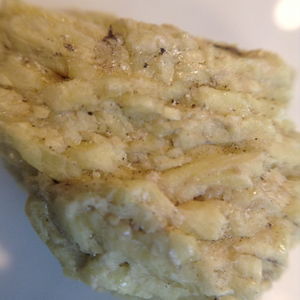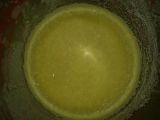Sulfur
 A native sulfur chunk of low purity | |||||
| General properties | |||||
|---|---|---|---|---|---|
| Name, symbol | Sulfur, S | ||||
| Alternative name | Sulphur | ||||
| Allotropes | More than 30 | ||||
| Appearance | Yellow solid | ||||
| Sulfur in the periodic table | |||||
| |||||
| Atomic number | 16 | ||||
| Standard atomic weight (Ar) | 32.065 | ||||
| Group, block | , p-block | ||||
| Period | period 3 | ||||
| Electron configuration | [Ne] 3s2 3p4 | ||||
per shell | 2, 8, 6 | ||||
| Physical properties | |||||
| Yellow | |||||
| Phase | Solid | ||||
| Melting point | 388.36 K (115.21 °C, 239.38 °F) | ||||
| Boiling point | 717.8 K (444.6 °C, 832.3 °F) | ||||
| Density near r.t. |
2.07 g/cm3 (alpha) 1.96 g/cm3 (beta) 1.92 g/cm3 (gamma) | ||||
| when liquid, at | 1.819 g/cm3 | ||||
| Critical point | 1314 K, 20.7 MPa | ||||
| Heat of fusion | 1.727 kJ/mol (mono) | ||||
| Heat of | 45 kJ/mol (mono) | ||||
| Molar heat capacity | 22.75 J/(mol·K) | ||||
| pressure | |||||
| Atomic properties | |||||
| Oxidation states | 6, 5, 4, 3, 2, 1, -1, -2 (a strongly acidic oxide) | ||||
| Electronegativity | Pauling scale: 2.58 | ||||
| energies |
1st: 999.6 kJ/mol 2nd: 2252 kJ/mol 3rd: 3357 kJ/mol | ||||
| Covalent radius | 105±3 pm | ||||
| Van der Waals radius | 180 pm | ||||
| Miscellanea | |||||
| Crystal structure | Orthorhombic | ||||
| Thermal conductivity | 0.205 W/(m·K) (amorphous) | ||||
| Electrical resistivity | 2×1015 Ω·m (at 20 °C) (amorphous) | ||||
| Magnetic ordering | Diamagnetic | ||||
| Bulk modulus | 7.7 GPa | ||||
| Mohs hardness | 2.0 | ||||
| CAS Registry Number | 7704-34-9 | ||||
| History | |||||
| Discovery | China (before 2000 BCE) | ||||
Sulfur (or sulphur) is a chemical element with the atomic number 16 and the symbol S. It is a brittle, yellow nonmetal with a very faint yet distinct odor. Sulfur is found commonly on Earth in elemental form and also in the form of sulfide and sulfate minerals. Pure sulfur is produced from volcanic emmisions.[1]
Contents
Properties
Chemical
When burned in air, sulfur burns with a blue flame and sulfur dioxide gas is formed. Sulfur will also react readily with the air to form sulfur dioxide when it is molten. Sulfur reacts with chlorine gas to form sulfur chlorides, namely disulfur dichloride and sulfur dichloride, and similarly reacts with bromine to form disulfur dibromide.[2]
Sulfur can be digested in a strong solution of sodium hydroxide to form sodium sulfide, a useful precursor to other sulfides.
Physical
Sulfur is a yellow solid under standard conditions. It is brittle; chunks of it can easily be broken by hand. Sulfur will melt at about 115 °C, and is a viscous, blood red liquid when molten. Sulfur is insoluble in most common solvents and water, but is soluble in carbon disulfide, benzene, toluene and xylene. There are over 30 allotropes of sulfur, more than any other element. The most common of these is α-octasulfur (S8), which is the form it is almost always seen in. When sulfur is melted and quickly cooled, amorphous polymeric sulfur is formed, which is light brown and has a rubbery consistency. It will only remain as this allotrope for a certain amount of time, varying from a few minutes to a few hours, eventually reverting back to octasulfur.[3]
Availability
Sulfur is the 10th most abundant element in the universe. Sulfur can be acquired at some garden stores as an insect repellent or fungicidal powder, although it is not usually very pure in these products, generally containing about 10% bentonite, a common clay. It can be extracted from the mixture by dissolving it in hot toluene or xylene, in which sulfur is very soluble. Once the mixture cools, elemental sulfur will begin to precipitate, as while it's very soluble in hot solvent, it's not very soluble when cold. Because the melting point of sulfur (115.21 °C) is slightly higher than the boiling point of toluene (111°C) and slightly below xylene's boiling point (138-144°C), it is best to avoid heating the precipitated sulfur too much as it will melt. Vacuum drying the sulfur is recommended, especially if there's a large quantity of it. Melting also works, but requires grinding afterwards.
Sulfur can be purchased in fairly pure form on the internet from chemical and industrial companies that are willing to sell to individuals.[4]
Sulfur can also be obtained by the decomposition (through heat) of cinnabar (mercury sulfide), which forms mercury and sulfur. This method is rather dangerous and complicated for any amateur, as it produces mercury vapor, which is highly toxic as well as an environmental hazard.
Preparation
Sulfur can be prepared by reducing sulfur dioxide with hydrogen sulfide, process known as "Claus process", used in industry to remove hydrogen sulfide. This is a very useful way to neutralize hydrogen sulfide, as opposed to burning it, as it produces elemental sulfur and water and does not generate dangerous gases.
Sulfur can also be made from thioethers, which take the form R-S-R':
- R-S-R + 2 H2 → 2 RH + H2S
- 2 H2S + SO2 → 3 S + 2 H2O
Projects
- Make polymeric sulfur
- Make gunpowder
- Make sulfides
- Make sulfuric acid
- Make aluminium sulfide
- Make hydrogen sulfide
- Make thermate
- Neutralize mercury and other toxic heavy metal spills
- Make sulfur chlorides and sulfur bromides
Handling
Safety
Elemental sulfur is not toxic, but when burned or melted it produces highly toxic sulfur dioxide gas. Care must be taken to perform any experiments involving sulfur dioxide in a fume hood or an otherwise well-ventilated area.
Sulfides react with many acids to produce extremely toxic hydrogen sulfide, which smells like rotten eggs.
Storage
Sulfur should be kept in closed bottles away from any flame source or acidic vapors.
Disposal
Burning sulfur is not recommended as it releases the toxic and corrosive sulfur dioxide. Although it may be dumped in the soil, large quantities will be oxidized by the microorganisms to sulfuric acid, which increases the acidity of the soil. Sulfur wastes are best disposed by mixing it with lime.[5]
Gallery
References
- ↑ http://en.wikipedia.org/wiki/Sulfur
- ↑ http://www.sciencemadness.org/talk/viewthread.php?tid=2467
- ↑ Shakhashiri, Chemical Demonstrations, Vol. 1
- ↑ http://www.dudadiesel.com/search.php?query=sulfur
- ↑ http://environment.gov.ab.ca/info/library/7417.pdf

